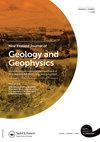新西兰中部奥塔哥马尼奥托托盆地耐盐生态系统中蒸发结壳的对比地质和矿物学
IF 1.9
4区 地球科学
Q1 GEOLOGY
New Zealand Journal of Geology and Geophysics
Pub Date : 2021-11-03
DOI:10.1080/00288306.2021.1987280
引用次数: 2
摘要
蒸发矿物结壳在马尼奥托托盆地三个不同地点的裸露基底上形成。帕特罗阿和贝尔蒙特两个地点的盐主要来自海洋气溶胶。Patearoa遗址发育在富含粘土的盘上,这些盘形成于被Taieri河侵蚀的阶地上,形成了粘土蚀变的片岩基底,蚀变片岩中的钠长石溶蚀导致碳酸钠与岩盐在pH ~ 10下析出。贝尔蒙特遗址位于一个活动冲积扇的平坦远端,岩盐为主的盐壳通过下方的毛细作用在薄而干燥的地壳上发育。在附近的汉密尔顿历史悠久的砂矿金矿,挖掘暴露了始新世含金沉积物下粘土蚀变的片岩基底。基底以高断裂和热液蚀变断裂带为主,含次生鲕状碳酸盐和黄铁矿。基底浅层地下水的水-岩相互作用使溶解的Mg和硫酸盐富集,遮蔽了海洋气溶胶组分,蒸发结壳以富镁矿物(水镁石和磷钼矿)为主。以盐岩为主的地点拥有罕见的盐生植物生态系统,但外来物种的逐渐殖民化最终将覆盖裸露的盐基质。汉密尔顿矿区的类似殖民化将导致废弃矿区的自然恢复。本文章由计算机程序翻译,如有差异,请以英文原文为准。
Contrasting geology and mineralogy of evaporative encrustations in salt-tolerant ecosystems, Maniototo basin, Central Otago, New Zealand
ABSTRACT Evaporative mineral encrustations have formed on bare substrates at three different sites in the Maniototo basin. Two sites, at Patearoa and Belmont have salts derived primarily from marine aerosols. The Patearoa site has developed on clay-rich pans formed on a terrace eroded by the Taieri River into clay-altered schist basement, and dissolution of albite from altered schist has resulted in precipitation of sodium carbonate with halite, at pH∼10. The Belmont site lies on the flat distal part of an active alluvial fan, and halite-dominated salt encrustations develop on thin dry crusts through capillary action from below. At the nearby Hamiltons historic placer gold mine, excavations exposed clay-altered schist basement beneath Eocene auriferous sediments. Highly fractured and hydrothermally altered fault zones dominate basement, with secondary ankeritic carbonate and pyrite. Water-rock interaction of shallow groundwater in the basement leads to enrichment in dissolved Mg and sulphate that overshadows the marine aerosol components, and evaporative encrustations are dominated by Mg-rich minerals including brucite and epsomite. The halite-dominated sites host rare halophyte ecosystems, but progressive colonisation by adventive species will eventually cover the bare saline substrates. Similar colonisation at the Hamiltons site will result in natural rehabilitation of the abandoned mine site.
求助全文
通过发布文献求助,成功后即可免费获取论文全文。
去求助
来源期刊
CiteScore
5.10
自引率
27.30%
发文量
34
审稿时长
>12 weeks
期刊介绍:
Aims: New Zealand is well respected for its growing research activity in the geosciences, particularly in circum-Pacific earth science. The New Zealand Journal of Geology and Geophysics plays an important role in disseminating field-based, experimental, and theoretical research to geoscientists with interests both within and beyond the circum-Pacific. Scope of submissions: The New Zealand Journal of Geology and Geophysics publishes original research papers, review papers, short communications and letters. We welcome submissions on all aspects of the earth sciences relevant to New Zealand, the Pacific Rim, and Antarctica. The subject matter includes geology, geophysics, physical geography and pedology.

 求助内容:
求助内容: 应助结果提醒方式:
应助结果提醒方式:


